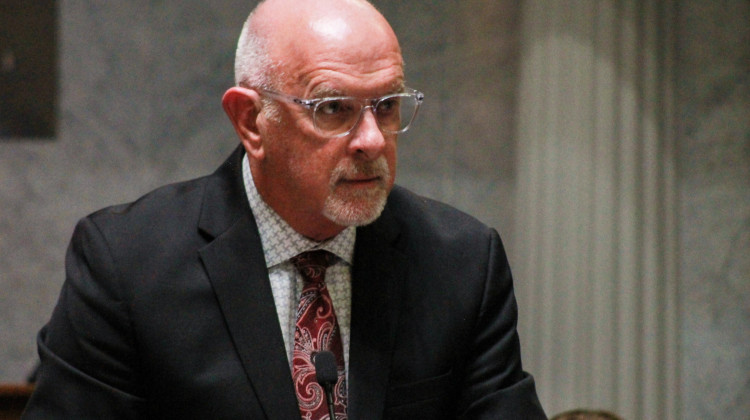
So far, the state has found PFAS in the treated drinking water at 10 Indiana water utilities.
Lauren Chapman/IPB NewsThe Environmental Protection Agency has proposed standards to limit six PFAS chemicals in drinking water. The agency hopes the standards will prevent thousands of deaths and tens of thousands of serious illnesses.
PFAS are human-made chemicals found in everything from carpets, to fast food wrappers, to firefighting foams on military bases — like Grissom Air Reserve Base near Kokomo. There are thousands of individual PFAS chemicals in the environment.
Among other things, exposure to them has been linked to kidney cancer, problems with the immune system, and developmental issues in children.
The EPA wants to limit two well-known PFAS chemicals — PFOS and PFOA — to 4 parts per trillion (ppt) in drinking water. That’s a lot lower than the current limit of 70 ppt, but also much higher than the agency’s health recommendations — which are near zero. No amount of PFAS is safe.
For the other four PFAS chemicals, water utilities would have to look at the combination of those chemicals and make sure there wouldn’t be an increased health risk for customers.
This way of looking at risk is a breakthrough, said assistant professor Marta Venier. She researches PFAS at Indiana University's Paul H. O’Neill School of Public and Environmental Affairs.
“We are exposed to what we call a chemical soup every day. We are never exposed to one single chemical at a time. And so while we know the effects of some of these PFAS — for more PFAS than the six that are currently under the proposed regulation — we what we don't know much about is what is the combined effect of our exposure to these chemicals." Venier said.
Venier said for this reason, the scientific community has been advocating to move away from regulating chemicals one-by-one.
Right now, it’s not clear how many Indiana water utilities would meet the proposed standards. The Indiana Department of Environmental Management is still working to test for PFAS at public water systems.
READ MORE: PFAS are more toxic than we thought. EPA sets new, temporary health guidelines
Join the conversation and sign up for the Indiana Two-Way. Text "Indiana" to 73224. Your comments and questions in response to our weekly text help us find the answers you need on statewide issues, including this series on climate change and solutions.
So far, IDEM has found PFAS in the treated drinking water at 10 Indiana water utilities. One of them, Indiana American Water in Charlestown, had 6 ppt of the chemical PFOA — which would be above the 4 ppt limit.
Adam Scherle is the plant superintendent at Patoka Lake Regional Water and Sewer District, which provides water to Tennyson Water Utility — which also had detectable levels of PFAS.
Scherle said PFAS are in so many products today — even the plastic gloves you see in a lab. That makes it hard to know whether there really is a problem with the water.
“Testing for these levels of contaminants is very, very hard. And to get it figured out so that everyone can reliably test is going to, I believe, take some time," Scherle said.
Though $10 billion from the federal infrastructure law will go to help utilities treat PFAS in drinking water, the EPA said it likely won’t be enough for every utility that needs it. That means their water rates could go up.
Cape Fear Public Utility Authority in Wilmington, North Carolina, installed granular activated carbon filters to deal with PFAS from the chemical company Chemours. The utility estimates the cost to operate the new filters will be about $5 million a year.
Environmental groups like the Sierra Club's Hoosier Chapter and the Environmental Working Group say rather than putting the cost on customers, the EPA needs to stop PFAS at its source and limit their use in manufacturing.
Rebecca is our energy and environment reporter. Contact her at rthiele@iu.edu or follow her on Twitter at @beckythiele.
9(MDAyMzk1MzA4MDE2MjY3OTY1MjM5ZDJjYQ000))
 DONATE
DONATE






 Support WFYI. We can't do it without you.
Support WFYI. We can't do it without you.